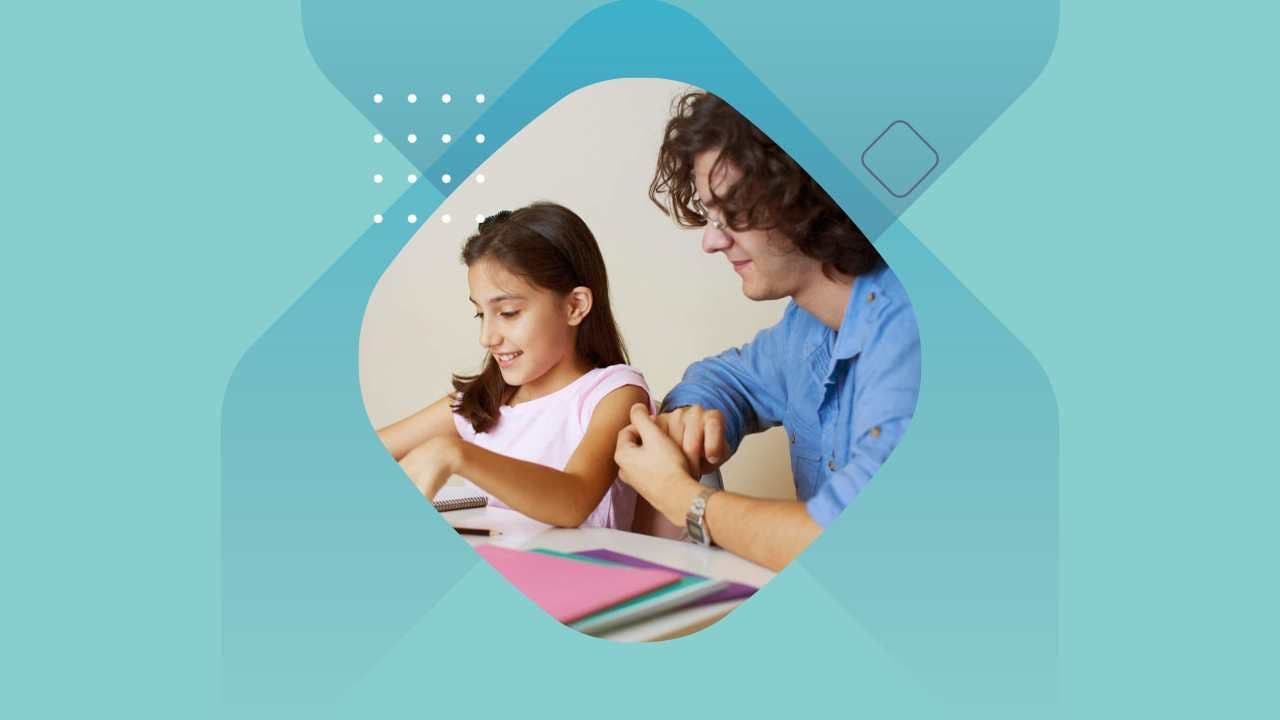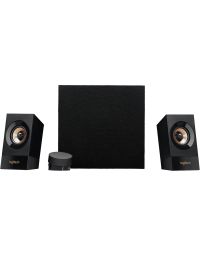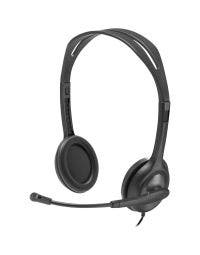In this article, you’ll explore the effect of quality audio in education; particularly how it impacts young learners ages 3-10 and can create effective learning environments.
Activating kids’ senses in education plays a huge role in promoting immersive and effective learning experiences. Not only does it keep students engaged longer, but it enhances the overall learning process and helps students retain information better. That’s because different parts of the brain are activated when multiple senses are engaged, leading to deeper levels of understanding and memory retention.
But what happens when one of those senses isn’t being used to its full potential? Namely, hearing.
According to a study published in the Journal Education Psychology Review, the percentage of learning comprehension that is based on hearing versus seeing can range from 60-75% for hearing and 25-40% for seeing, depending on the complexity of the material being learned1.
Because of that, poor audio quality in education can really get in the way of effective learning. Studies have shown that poor audio quality can have a direct, negative effect on both engagement2 and comprehension for young learners.
On the flip side, good-quality audio and listening experiences can make a world of difference as students develop their knowledge and skills. It can lead to better comprehension, retention, stamina, focus, and engagement.
So let’s dive into it. In this short read, we’ll tune in to some of the positive effects quality audio can have on education, and see how we can leverage great-quality sound to amplify the learning experience for younger learners.
Sound good?


Audio Quality’s Effect on Education
Improved Comprehension
Studies have shown that high-quality audio can significantly improve comprehension among young learners. When students are able to hear and understand what is being taught clearly, they are better able to engage with the material and make connections between different concepts.
A study published in the Journal of Educational Psychology found that students who listened to high-quality audio recordings of lectures scored an average of 7.5% higher on comprehension tests than those who listened to recordings with poor sound quality. This is backed up by another study conducted by the University of Maryland Medical Center, which also found that students who listen to audio recordings with good quality performed better on comprehension tests3.
This is of particular importance for younger students who are still developing their comprehension and language skills.
Language Development
Young learners who are still developing language skills need to hear the language spoken clearly and consistently in order to build a strong foundation for communication and literacy. This is particularly important for students for whom English is a second language.
In another study published in the Journal of Educational Psychology, students exposed to high-quality audio recordings of the English language were not only better able to understand and produce the language but were more likely to show improvement in their language skills over time than those who used low-quality audio recordings4.
Moreover, high-quality audio can also help to support the development of phonemic awareness, which is the ability to identify and manipulate individual sounds within words. Phonemic awareness is a key component of early literacy development, as it helps students to develop the skills they need to read and write5,6.
Learning Retention
In addition to improving comprehension and reinforcing language skills, high-quality audio can also enhance memory retention among young learners. When students are able to hear and understand lessons clearly, they are more likely to remember the information later on. This is because audio can provide important cues that help reinforce memory, such as tone of voice, inflection, and emphasis.


Delivering Quality Audio in Education Settings
There are two parts to bringing quality audio to educational settings: input and output (AKA how you capture and deliver sound).
Input (e.g. Microphones)
For educators, there are a number of reasons why you may need to capture audio. Perhaps you follow the flipped classroom model and need to create prerecorded lessons. Maybe you teach virtually to remote learners. In instances like these, having a good microphone can really level up the instructional experience you are creating. Even a budget-friendly external microphone can greatly improve the audio quality of your recordings when compared with your computer’s built-in mic.


For live, in-person instruction, you may find it helpful to pair a lapel mic with your classroom speaker system to deliver louder, clearer sound to your entire classroom and better reach those students in the back of the room.
Microphones can also be a helpful tool for students as many applications require speaking exercises. Knowing that they are being heard clearly helps students build confidence in their language skills.
Output (e.g. Speakers, Headphones, and Headsets)
Stick the landing with great delivery of quality audio in the classroom. Here are some tools we recommend considering to improve audio experiences while using different types of technology like interactive whiteboards, laptops, or desktop computers.
Speakers: Say you’re showing a YouTube video of a chemical reaction on your room’s interactive board or playing a recording of a famous speech from your teacher device. Odds are the built-in speakers in either aren’t crystal clear (with a few exceptions like the Promethean ActivPanel 9 Premium which comes with built-in sub-woofers). For classroom displays, connecting a speaker or classroom audio system can really optimize the sound experience and immerse students in the media you’re sharing with them.
In fact, students in sound-amplified classrooms scored an average of 35% higher on the Dynamic Indicators of Early Literacy Skill7.


Headphones and Headsets: Independent study, remote learning, and testing are all occasions where headphones and headsets can really come in handy. That’s due to the fact that ambient noise affects young learners to a greater degree than their older counterparts. When focusing on a task, kids aged 6-12 require sound to be 300% louder than background noise8.
That translates clearly into how ambient noise affects testing. For learners ages 8-10, high ambient noise leads to “significantly worse standardized test results” after accounting for variables9.
Providing students with headphones and headsets helps them shut out the extra noise. The added focus and improved comprehension allows students to excel at a new level when learning and testing with audio-centric multimedia.
Spotlight: Logitech Zone Learn
“Meet the new Logitech Wired Headsets that are designed for effective learning and built for schools.”
The Zone Learn series of headphones and headsets–recently introduced by Logitech–are made with young learners in mind. Rooted in research, this new line of education-focused headsets was designed to boost comprehension, enhance engagement, and improve learning stamina for K-8 students. They feature a smaller arc to fit a smaller head size, and soft, comfortable ear pads “that kids love!”


What’s more, they are school friendly, meaning they are durable (military-grade drop tested up to 4 ft) and cleanable (tested to withstand 3 years of daily cleaning).


Zone Learn also comes in versatile ordering options, with the ability to customize sets that perfectly suit your learning environments. Choose between over-ear or on-ear, then pick the cable type that plays well with the rest of your classroom technology (3.5 mm AUX, USB-A, or USB-C).
Speaking of “plays well”, Zone Learn works with hundreds of effective learning apps like Kami, Epic, Duolingo ABC, and more.
Interested in trying Logitech Zone Learn at your school? Contact Trafera sales today to set up a demo or get fast quotes.
Image Credit: Logitech for Education Sources:
1. Mayer, R. E. (2014). Cognitive theory of multimedia learning. In R.E. Mayer (Ed.) The Cambridge Handbook of Multimedia Learning (2nd ed., pp. 43-71). Cambridge University Press.
2. Gustafson, T. J., Au. D. (2011, November 11). Dual Task Performance of School Age Children: Listening in Noise [PPT[. Lubbock: Texas Tech University Health Sciences Center Department of Speech, Language, and Hearing Sciences.
3. University of Maryland Medical Center. “Sound quality affects students’ comprehension.” ScienceDaily, 27 March 2013.
4. Zheng, X., & Ercan, O. (2015). Effects of Audio Quality and Task Difficult on Learning English as a Foreign Language. Journal of Educational Psychology, 107(2), 497-508.
5. Oczkus, L. (2003). Best practices in phonemic awareness instruction. The Reading Teacher, 56(2), 192-193.
6. Wong, P. C. M., & Perrachionne, T. K. (2007), Learning pitch patterns in lexical identification by native English-speakings adults. Applied Psycholinguistics, 28(4), 565-585.
7. Students in sound-amplified classrooms scored an average of 35 percent higher on the Dynamic Indicators of Early Literacy Skills. Cherilus, L. Oregon research study 2004 Focus & Stamina.
8. Moore, R.E. Phd.D. (n.d.). A Comparison of Acceptable Noise Levels in Children and Adults [PPT]. Mobile: University of South Alabama.
9. Pujol, S., Levain, J. Houot, H., Petit, R., Berthillier, M., Defrance, J., Mauny, F. (2013). Association between Ambient Noise Exposure and School Performance of Children Living in an Urban Area: A Cross Sectional Population-Based Study. Journal of Urban Focus & Stamina.



![[Webinar] Empowering Teachers as Content Creators feat. Logitech](https://www.trafera.com/media/amasty/blog/cache/E/m/1280/720/EmpoweringTeachersasContentCreatorsLogitech_Blog.jpg)























